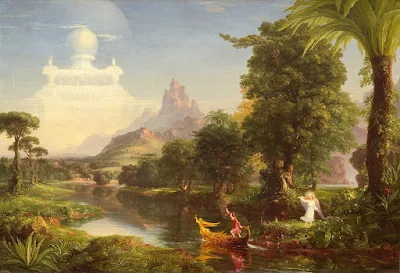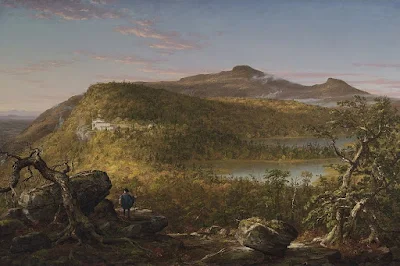Thomas Cole: Pioneering the American Landscape
Thomas Cole, an English-born American artist, stands as a monumental figure in the annals of art history, particularly renowned as the founder of the Hudson River School art movement. With a profound appreciation for the natural world and a unique artistic vision, Cole's work transcends mere landscapes, offering viewers a glimpse into the soul of America.
Let's delve into the life and legacy of this visionary artist who reshaped the American artistic landscape.
A Glimpse into Early Life
Born on February 1, 1801, in Bolton le Moors, Lancashire, Thomas Cole embarked on a journey that would lead him to become one of the most influential landscape painters in American history. His family immigrated to the United States in 1818, settling in Steubenville, Ohio, where Cole's artistic inclinations began to take root.

Nurturing the Seeds of Artistry
From a young age, Cole displayed an innate talent for drawing and painting. Despite lacking formal artistic training, he immersed himself in the world of art through books and by studying the works of other artists. It was this self-driven pursuit of excellence that laid the foundation for his future success.
Shaping Artistic Vision
Cole's artistic journey took a pivotal turn when he moved to Catskill, New York, in 1825. Surrounded by the breath-taking landscapes of the Hudson Valley, he found inspiration that would shape his distinctive style characterized by romanticism and meticulous attention to detail.
The Birth of a Movement
As a visionary artist, Cole's work transcended mere representation, delving into the realm of allegory and symbolism. His iconic series, "The Course of Empire," captures the cyclical nature of civilization, from its infancy to its eventual decline—a theme that resonated deeply with his contemporaries.
Navigating Success and Recognition
Cole's artistic prowess garnered widespread acclaim, earning him recognition from esteemed patrons and fellow artists alike. Notable figures such as John Trumbull and Asher B. Durand recognized his talent early on, propelling him into the spotlight of the art world.
A Journey Across Continents
In 1842, Cole embarked on a Grand Tour of Europe, immersing himself in the works of the Old Masters while honing his craft amidst the scenic splendour of the continent. His encounters with Europe's natural wonders, particularly Mount Etna, left an indelible mark on his artistic sensibilities.
Beyond the Canvas - Poetry and Architecture
Cole's artistic pursuits extended beyond the realm of painting, encompassing poetry and architecture. His multidisciplinary approach to creativity reflects a deep-seated passion for exploration and expression across various mediums.
Personal Reflections
Amidst his artistic endeavors, Cole found solace and companionship in his personal life. His marriage to Maria Bartow of Catskill and the joys of fatherhood provided a sense of balance amidst the demands of his burgeoning career.
Legacy and Remembrance
Thomas Cole's legacy endures through the countless masterpieces he left behind, each a testament to his unwavering dedication to his craft. His impact reverberates through the corridors of art history, inspiring generations of artists to explore the beauty of the natural world.
Honours and Tributes
Thomas Cole's legacy endures through the countless masterpieces he left behind, each a testament to his unwavering dedication to his craft. His impact reverberates through the corridors of art history, inspiring generations of artists to explore the beauty of the natural world.

Discovering Thomas Cole's Masterpieces
A Journey Through His Iconic 16 Artworks
Frequently Asked Questions
☛ What is Thomas Cole best known for?
Thomas Cole is best known for his role as the founder of the Hudson River School art movement and his pioneering work in American landscape painting.
☛ Where was Thomas Cole born?
Thomas Cole was born in Bolton le Moors, Lancashire, England.
☛ What influenced Thomas Cole's artistic style?
Thomas Cole's artistic style was influenced by European painters, but he also incorporated a strong American sensibility into his work, particularly in his portrayal of the American landscape.
☛ What are some notable works by Thomas Cole?
Some notable works by Thomas Cole include "The Course of Empire" series, "The Oxbow," "The Voyage of Life," and "The Garden of Eden."
☛ Did Thomas Cole have formal artistic training?
No, Thomas Cole was largely self-taught as a painter, relying on books and studying the works of other artists to develop his skills.
☛ Where can I see Thomas Cole's artwork?
Thomas Cole's artwork can be found in various museums and galleries, including The Metropolitan Museum of Art in New York and the National Gallery in Washington, D.C.
☛ What is "The Course of Empire" series about?
"The Course of Empire" series by Thomas Cole depicts the rise and fall of civilization, exploring themes of progress, power, and decay.
☛ Did Thomas Cole have any other artistic pursuits besides painting?
Yes, Thomas Cole was also a poet and dabbled in architecture, showcasing his multidisciplinary approach to creativity.
☛ Where is Cedar Grove, Thomas Cole's home and studio, located?
Cedar Grove, also known as the Thomas Cole House, is located in the town of Catskill, New York.
☛ How did Thomas Cole pass away?
Thomas Cole passed away on February 11, 1848, due to pleurisy, leaving behind a profound legacy in the world of art.
Conclusion
Thomas Cole's artistic journey serves as a testament to the transformative power of creativity and the timeless allure of the natural world. As we reflect on his life and legacy, let us continue to draw inspiration from his unparalleled vision, forever etched into the tapestry of American art.
Explore more American Artist
Courtesy, Credits and Thanks
Explore more about Artist Thomas Cole
en.wikipedia.org: Explore the life and works of Thomas Cole, the influential American landscape painter, on Wikipedia. Learn about his contributions to art history.



























